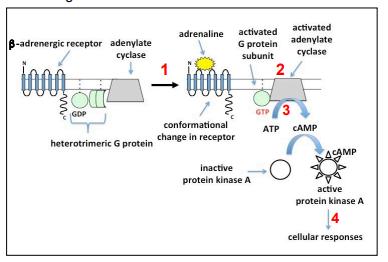Question
The diagram below shows a signaling pathway that is activated following the binding of adrenaline to the -adrenergic receptor. The major steps of this signaling
The diagram below shows a signaling pathway that is activated following the binding of adrenaline to the β-adrenergic receptor. The major steps of this signaling pathway are outlined below and also shown on the diagram Step 1: When the β-adrenergic G protein--coupledreceptor is not bound to adrenaline, the Gprotein attached to the receptor has a GDPnucleotide bound to it. Binding of adrenaline
Step 1: When the β-adrenergic G protein--coupledreceptor is not bound to adrenaline, the Gprotein attached to the receptor has a GDPnucleotide bound to it. Binding of adrenaline
hormone (which travels through the bloodstream) changes the conformation of the
receptor. This conformation change in thereceptor affects the conformation of the G
protein bound to it and causes the GDP to falloff and be replaced with a GTP molecule.
Step 2: Active GTP--boundG protein detachfrom the receptor and it activatesadenylate
cyclase.- The G protein can be inactivated by thehydrolysis of bound GTP to GDP.
Step 3: Activated adenylate cyclase mediates the formation of cAMP from ATP.
Step 4: The cAMP produced diffuses through the cell to bind and activates Protein kinase A (PKA). PKA affects
many proteins in the cell by attaching a phosphate group to them. The phosphorylated proteins induce cellularchanges that mediate the increased heart rate and accounts for the flight-or-fight response.
a) To further understand the above signaling pathway, you examine it in the following cells that arecultured in the following conditions (#1-#3)
• #1: Cells are treated with cholera toxin that locks the activated G proteins in their GTP bound form.
• #2: Cells are treated with pertussis toxin that locks the G proteins in their GDP bound form.
• #3: Cells have a receptor that activates the G proteins independent of the ligand.
In which of the conditions would you see a constitutive activation of adenylate cyclase independent ofadrenaline hormone? Explain why you selected this condition.
b) Why is the effect of adrenaline limited to a specific cell type in an individual?
c) Would you regard the adrenaline hormone mediated signaling pathway as endocrine/ apocrine/ autocrine/ juxtacrine? Explain why you selected this option as opposed to the others.
d) Identify the first step in the signaling pathway where the signal starts to get amplified:
e) Consider the following homozygous mutations in different components of this pathway.
• M1: The β-adrenergic receptor constitutively stays in its ligand bound form
• M2: Adenylate cyclase can no longer bind to ATP
• M3: PKA continues to stay in its active form
• M4: The cell produces a variant of β-adrenergic receptor that lacks 4 of its 7 transmembrane domains
Complete the table for the cells that are incubated with adrenaline and have the following mutations.
Predict the change in heart rate by comparing the mutations with control, wild type, adrenaline treated
cells.
f) Unlike adrenaline hormone, ligands such as testosterone (shown below) can diffuse into the target cell and mediate cell signaling by binding to the intracellular receptors. What property of these ligands allows them to diffuse? 
3-adrenergic receptor adenylate inni u GOP cyclase heterotrimeric G protein adrenaline m activated G protein subunit activated adenylate cyclase 2/ conformational change in receptor 3 ATP CAMP ACAMP inactive protein kinase A active protein kinase A cellular responses
Step by Step Solution
There are 3 Steps involved in it
Step: 1
The detailed answer for the above question is provided below a It is condition 3 since the adrenergi...
Get Instant Access with AI-Powered Solutions
See step-by-step solutions with expert insights and AI powered tools for academic success
Step: 2

Step: 3

Ace Your Homework with AI
Get the answers you need in no time with our AI-driven, step-by-step assistance
Get Started

